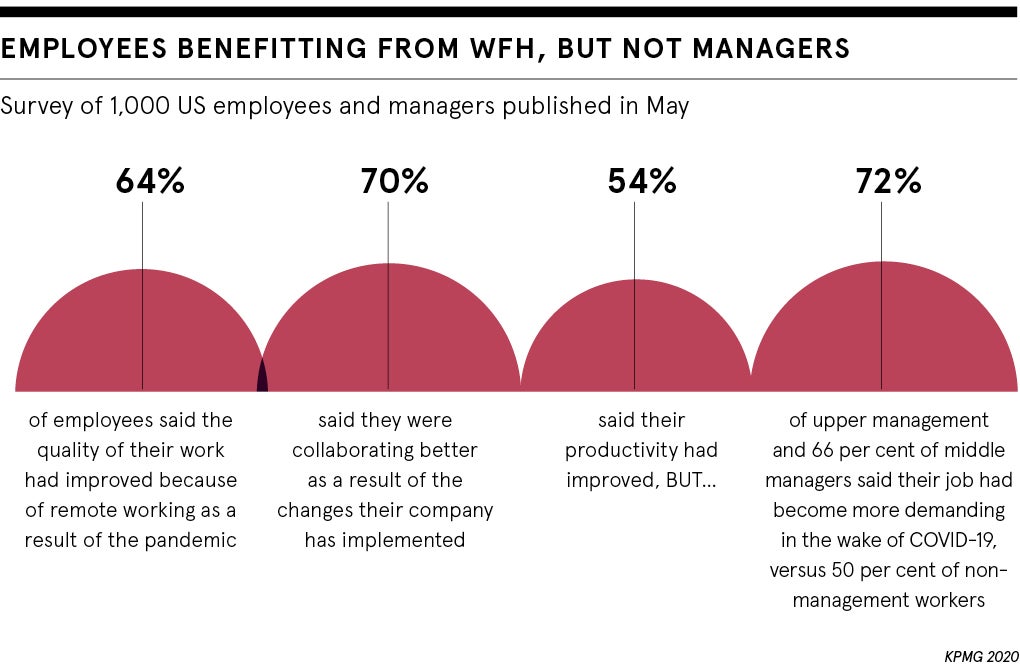The great work-from-home experiment has now been running for several months. We may have been physically working apart from our peers, but this hasn’t stopped us from needing to collaborate. Watercooler chats, stand-up meetings and quick catch-ups have been replaced by Zoom calls and Slack messages.
Has this lack of proximity made working together harder? Or has time away from our colleagues made our interactions more fruitful?
How tech can facilitate remote collaboration
Collinson Group, a global loyalty and benefits company, has seen little drop off in employee satisfaction or productivity since the breakout of coronavirus. In July, 79 per cent of its 2,100-plus employees reported they were working efficiently with their colleagues, a 12 per cent increase since the previous survey in April.
“We have found we are just as effective and just as productive with 80 per cent of our people agreeing they have been performing as or more effectively than pre-COVID,” says Corey Archard, Collinson’s head of talent acquisition. “Collaboration across our global offices has become slightly easier with an increased number of meetings taking place between different office locations.”
Archard cites Collinson’s speed in implementing new technologies as being crucial in their positive results. Digital collaboration tools have become ubiquitous in our working lives. Zoom saw its global daily users spike from 10 million to 200 million during the first month of lockdown, while Microsoft Teams, Slack and TeamViewer have also seen a sharp increase in demand.
“Any tool that organisations choose to encourage collaboration and sharing must be simple to use and integrate seamlessly into existing IT set-ups,” says Andy Wilson, global head of media technologies at Dropbox. “New tech should work as intuitively in the office as it does at home. Put simply, these tools need to be able to meet the demands and preferences of everyone that uses them.”

A culture of collaboration is the first step
While technology has obviously been crucial in facilitating collaboration, the first step is fostering a culture that promotes effective teamwork.
“It is not difficult to specify the characteristics of a high-performing team,” says Adrian Furnham, occupational psychologist for financial advisory firm Stamford Associates. “They develop clear goals and plans; they communicate clearly, honestly and regularly with each other; they solve problems and make decisions on a timely basis; they manage conflict well.”
At the law firm DLA Piper, collaboration has been a focus for the past two years, following a reset of the practice’s values.
“Ensuring people’s emotional wellbeing and working supportively were already embedded in the business,” says the global law firm’s international head of talent development Liza Strong. “It hasn’t been a leap. Allocating work and tasks has always been done in a collaborative way, with a clear set of shared objectives.”
Widespread remote working has accelerated the transition from command-and-control leadership to focusing more on output. This trend is set to snowball further, as polling by the global research firm Gartner found that just under half (48 per cent) of employees expect to be working from home following the pandemic.
Managers will need to allow time and space for their staff, earmarking periods when solitary work is encouraged. The average UK worker has 4.4 meetings a week, half of which they deem to be unnecessary, according to a 2018 report by the meeting tech firm eShare.
Dropbox’s engineering team have implemented a “No meeting Wednesday” policy to allow staff to work through complex programming challenges and facilitate better interactions during the rest of the week.
“Teams may need to be able to set aside ‘focus time’ as a result of working from home where distraction is aplenty,” says Wilson. “Not every company update needs a team meeting and not every piece of feedback needs to be conveyed instantly.”
The pros and cons of virtual communication
Despite the desire to work from home and the capability of digital tools, there are still drawbacks to the lack of face-to-face contact with our colleagues.
“There are all sorts of constraints when it comes to virtual communication,” says Furnham. “People need to get to know each other well so they can trust and like them. It is the ‘watercooler moments’ that make all the difference in getting to know people’s preferences.”
He suggests that video calls are often too formal, restricting participants from speaking their mind or sharing ideas. Furnham also points out the importance of visual cues and body language in understanding the perspectives of workmates.
Even if someone is quarantine or shielding, we want everyone to be involved in those moments and to start from the same base
Research by Adecco Group found 77 per cent of British workers would prefer to adopt a hybrid model, splitting their time between office and home. As we move back into the shared workspace, how should leaders handle the need for face-to-face interactions, while still including staff who work remotely?
Strong says all DLA Piper meetings involving remote workers take place via video conferencing to avoid excluding people from key decisions.
“It’s often at the start or the end of the meeting where incredibly valuable informal conversations are had,” she says. “Even if someone is quarantine or shielding, we want everyone to be involved in those moments and to start from the same base.”
This desire to keep people involved touches again on the need for a commitment to collaboration throughout an organisation. A supportive and trusting culture goes a long way to keeping teams performing at a high level, whether the conversations happen over Zoom or by the watercooler.
The great work-from-home experiment has now been running for several months. We may have been physically working apart from our peers, but this hasn’t stopped us from needing to collaborate. Watercooler chats, stand-up meetings and quick catch-ups have been replaced by Zoom calls and Slack messages.
Has this lack of proximity made working together harder? Or has time away from our colleagues made our interactions more fruitful?
